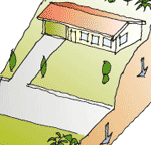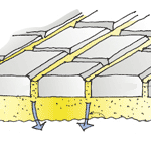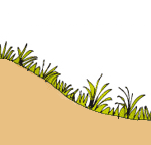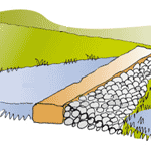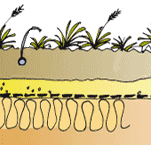Water
Water use, sustainability, and efficiency by choosing quality systems and materials, and providing environmentally friendly solutions.
Stormwater control and landscaping
Careful planning of stormwater management can reduce the pressure on council stormwater systems, cut water use in a household and protect waterways from contamination.
On this page:
- controlling stormwater runoff
- rainwater storage
- permanent paving
- swales
- green roofs
- reducing garden water use
Stormwater must be managed to minimise the risk of flooding. But allowing all stormwater from a property to run into drains not only wastes a potential source of garden water but also means that contaminants such as oil, paint and animal droppings are carried into waterways.
Stormwater can instead be harnessed for irrigation or otherwise disposed of on-site, reducing demand on a property’s water supply. With an estimated 10-30% of household water used for gardening, this can have benefits in terms of water efficiency.
Similarly, garden water use can be reduced by selecting plants that require little water, by collecting and using rainwater (which also has the effect of reducing stormwater runoff), and/or by using greywater for garden irrigation.
In some areas there are now council rules around runoff that new construction must comply with. Under Auckland's Unitary Plan, for example, rainwater runoff after a new development must not be any greater than the runoff that occurred before the development. On the Kapiti Coast, all new residential developments must be “hydraulically neutral” – new housing areas cannot discharge additional stormwater into the council’s system.
The Acceptable Solution E1/AS2 for stormwater references AS/NZS 3500.3:2021 Plumbing and drainage Part 3: Stormwater drainage (with modifications) as an Acceptable Solution for the design and installation of surface water drainage systems. MBIE referenced the 2021 version of the standard in November 2023, with a 12-month transition period ending in November 2024.
Controlling stormwater runoff
Stormwater may be disposed of:
- into a local authority stormwater system – either directly, or by slow release with the use of an on-site detention tank. Detention tanks are readily available in different sizes and can be installed above or below ground
- into a soak pit, following the guidance in New Zealand Building Code Verification Method E1/VM1. This may require a building consent
- into a retention tank, to store water for gardening, toilet flushing etc. (but not drinking)
- into a raingarden with suitable planting
- into a natural watercourse (with local authority consent)
- water from roofs can be harvested into a water storage tank for all water requirements.
In a natural landscape rainwater surface runoff averages about 27% but in urban areas, due to the increase in hard surfaces such as roads, driveways and reduced vegetation, average runoff is in the region of 58%. Runoff can cause pollution by carrying soil, contaminations (such as fuel) from roads and vehicles, human and animal waste, and chemicals (e.g. fertilisers, pesticides, industrial chemicals and household cleaners) into waterways.
Stormwater runoff can be reduced by:
- collecting and storing rainwater in storage tanks
- using permeable paving
- incorporating swales to slow the rate of surface water movement
- planting a rain garden. Slightly below road level, rain gardens are filled with plants such as rushes and irises that love water
- retaining or planting trees
- installing a green roof as part of a new building design.
Rainwater storage
Stormwater runoff can be reduced by collecting and storing rainwater for gardening, toilet flushing or other uses. This also has other benefits, such as reducing water costs for properties on metered supply, and reducing demand on other stormwater disposal systems.
Permeable paving
Stormwater runoff rate can be reduced by using permeable paving for driveways, footpaths and parking areas instead of hard, impervious paving such as asphalt or concrete.
Permeable or porous surfaces include:
- gravel
- concrete-grass paving
- porous concrete/asphalt
- open-jointed paving over gravel
- green roofs
- proprietary paving stones where water flows through the paver itself
- perforated polypropylene units that can be filled with gravel or pebbles.
Permeable surfaces are best suited to:
- areas with a slope of 1:10 (5°) or less
- low traffic volumes
- low speed traffic.
Stormwater runoff will be slowed by open paving blocks that allow water to infiltrate through gaps. Grass is usually planted in the gaps.
Paving blocks on a sand base and with open joints can be used to slow rainwater runoff but they are not as permeable as concrete/grass paving options.
Swales
Swales are wide, shallow drainage channels running across the slope of the ground that forms part of the landscape. They reduce runoff rate by:
- retarding the flow rate of surface water
- providing a means of infiltration into the subsoil.
Swales should be wide and shallow, with a gradient across the slope of less than 1:25. They can be grass covered and mown infrequently, or filled with water-loving plants. There are many suitable native options, from small reeds to nikau palms. On steeper slopes, they should include a check dam to slow the flow rate. If used for driveways over 30 metres long, an underdrain should be incorporated.
Run-off is slowed and absorption of rainwater into the ground is increased by use of a check dam on sloping ground.
Retaining or planting trees
Retaining mature trees on a site, or planting trees, can reduce the volume of rainwater hitting the ground in the first place. Trees catch rainwater, holding it in their canopies and allowing it to gradually evaporate from there. This “canopy interception” for large trees has been found to average around 500–650 litres per tree, per storm in American research. Approximately 20–40% of rainfall can be caught by a tree canopy, preventing it from reaching the ground and the stormwater system.
Green roofs
A green roof has vegetation planted into a layer of growing/drainage medium laid over a waterproof membrane. Green roofs help to reduce the water runoff rate by retaining the water, which is then lost through slow drainage, transpiration and evaporation.
Pitched roofs up to 25º are suitable as green roofs, but lower pitches require less depth of growing medium. Steeper roofs require a deeper layer and measures to prevent erosion. Obtain specialist advice before deciding on the type of growing medium and plants to use.
Disadvantages of green roofs include:
- they cost more
- the roof is heavier than a conventional roof and will require additional structure for support
- they require specific design under the NZ Building Code
- the membrane, flashings and rainwater collection and retention system must be carefully designed and detailed to prevent deterioration from plant roots and damp conditions
- if the roof leaks, it may be difficult to find the cause, and the cost of repairing it will be expensive
- they are likely to require more maintenance than a conventional roof
- in arid regions, they require an irrigation system for the plants, which will increase the cost.
Advantages of green roofs include:
- protection of the waterproof membrane by the growing medium from ultraviolet light
- they reduce the rate of rainwater runoff
- good noise reduction
- a natural appearance that blends into the landscape.
Reducing garden water use
The amount of water needed for garden irrigation can be reduced significantly by selecting plants that require little water.
Observe plants that grow well with limited or no watering within the local area. This will give a good guide to plants that are largely self-maintaining and will not require extensive irrigation.
Garden water use can also be reduced by using an efficient irrigation system – that is, one that applies a smaller volume of water directly where it is needed, such as by drip irrigation rather than sprinklers.
Water use should be controlled by the use of timers (for example, to water in the evening to reduce the amount of water evaporation) and/or in-ground moisture meters.
Other ways to reduce garden water use include storing and using rainwater for irrigation, using greywater for irrigation, and diverting stormwater for irrigation instead of allowing it to run into drains (see above for details).
Updated: 02 November 2023


